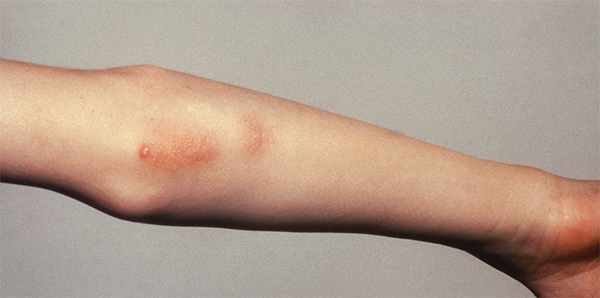Although most systemic juvenile idiopathic arthritis patients don’t develop macrophage activation syndrome (MAS), the approximately 10% who do have this serious complication can experience widespread, massive inflammation, debilitating symptoms and even death.
To improve understanding of MAS among physicians and advance efforts to develop effective therapies to treat it, a panel of 28 international pediatric rheumatologists and pediatric hematologists collaborated to create new set of classification criteria for this severe, systemic inflammatory process. These new criteria were developed as a collaborative project of the American College of Rheumatology (ACR), the European League Against Rheumatism (EULAR) and the Paediatric Rheumatology International Trials Organisation (PRINTO).
Classification criteria can help rheumatology researchers more accurately identify patients to be enrolled in clinical trials, says one of the panelists involved, Rayfel Schneider, MBBCh, FRCPC. Dr. Schneider is professor and associate chair of the Department of Paediatrics at the University of Toronto and Hospital for Sick Children in Toronto, Ontario. Because MAS can be deadly, high-quality trials for new therapies are crucial, spurring the major rheumatology research organizations to collaborate to develop new classification criteria.

Elbow of a patient with juvenile idiopathic arthritis, sometimes called juvenile rheumatoid arthritis or adolescent-onset Still’s disease; the most common form of arthritis seen in children and adolescents.
“MAS can rapidly progress to multi-organ failure, associated with significant mortality,” says Dr. Schneider. “Early diagnosis and treatment are essential. The absence of validated diagnostic criteria makes the early diagnosis of MAS challenging.”
Classification criteria differ from diagnostic criteria in that they provide a standard profile of a patient with a particular condition, and their purpose is to improve the interpretation of findings from different studies. The new MAS in systemic JIA classification criteria were simultaneously published in March in the journals Arthritis & Rheumatology and the Annals of the Rheumatic Diseases.1
Based on the results of this multi-year, multi-step process to evaluate existing criteria and achieve high consensus on which ones were most useful in recognizing an MAS patient, the panel produced these criteria:
“A febrile patient with known or suspected systemic juvenile idiopathic arthritis is classified as having macrophage activation syndrome if the following criteria are met: Ferritin >684 ng/mL and any two of the following: Platelet count ≤181 X 109/L; aspartate aminotransferase >48 units/L; triglycerides >156 mg/dL; or fibrinogen ≤360 mg/dL.”
Broad Consensus
This large-scale project and the selection of the international panel to produce the new criteria was coordinated by Angelo Ravelli, MD, of the Universita degli Studi di Genova and Istituto Giannina Gaslini in Genoa, Italy, and Randy Q. Cron, PhD, of the University of Alabama at Birmingham.

Dr. Schneider
“It began with a Delphi survey of the international pediatric rheumatology community to select the most suitable candidate classification criteria,” says Dr. Schneider. “This was followed by the large-scale collection of data from both patients with MAS and relevant controls with ‘confusable’ diagnoses, active systemic JIA or systemic infections from multiple international centers.”
The panelists reviewed hundreds of brief, real patient clinical and laboratory profiles through web-based communication, and were asked to determine whether each one should be classified as having MAS or not, says Dr. Schneider.
“Potential MAS definition criteria were derived from these data and were then further evaluated at an international consensus meeting” held in Genoa on March 21–22, 2014, he says. “Selected definitions of MAS were ranked by the conference participants, and a final definition was determined based on 80% consensus among the participants.”
The broad, international mix of the panelists, along with that high level of consensus of their evaluations, means that the process adequately addressed any potential geographic or regional disparities in MAS classification, says Dr. Schneider.
Why MAS Criteria Matter
In MAS, a malfunctioning immune system causes both macrophages and T-lymphocyte cells to activate continuously. This triggers an overexpression storm of inflammatory cytokines. Patients may experience an array of clinical symptoms as a result, including high fever, liver and spleen swelling, lymphadenopathy, dysfunction of the central nervous system and hemorrhaging.
Patients with JIA are not the only ones at risk for developing MAS. It’s also found in adult-onset Still’s disease, the adult equivalent of systemic JIA. Reports of MAS in patients with both juvenile and adult systemic lupus erythematosus, Kawasaki disease, and periodic fever syndromes are increasing as well, according to the paper Dr. Schneider co-authored.
Knowledge gaps make these new criteria an important step toward improved care for these at-risk, juvenile patients, says Dr. Schneider.
“It is widely recognized that the guidelines for the diagnosis of primary hemophagocytic lymphohistiocytosis are not sufficiently sensitive for the diagnosis of MAS in the context of systemic JIA, particularly with regard to making an early diagnosis,” he says. “Classification criteria for MAS are essential in facilitating research to further our understanding of the pathogenesis of MAS in systemic JIA, and to identify new biomarkers and effective treatments.”
MAS can cause multiple organ failure if a treating physician doesn’t identify and treat it, and recent studies suggest its mortality rate may be about 8%. However, MAS is not easy to recognize, as it doesn’t have telltale clinical and laboratory signs. In fact, doctors may confuse MAS for other conditions, even for a flare of the patient’s systemic JIA. Patients may present with a wide, disparate array of clinical or laboratory features, making early, life-saving intervention a huge challenge.
Collaborative Effort
Developing new, more accurate classification criteria for MAS in systemic JIA was a multistep process. First, the panelists were asked to classify 428 selected patient profiles as having or not having MAS based on clinical and laboratory features at the onset of disease. Out of these 428 profiles, 161 had MAS associated with systemic JIA, and 267 had conditions that could potentially be mistaken for MAS, such as systemic infection.
The panelists statistically tested 982 candidate criteria for systemic JIA-related MAS and evaluated how well these criteria accurately classified the MAS patients. The 37 best-performing criteria and eight criteria derived from existing literature were examined and evaluated by the panel. They achieved consensus on the classification of 391 of the 428 patient profiles, or 91.4%. The panelists reached 82% consensus on the final MAS classification criteria. In validation analyses, the criteria’s sensitivity was 0.73, and their sensitivity was 0.99. In addition, there was high agreement (0.76) between the classification of MAS or not MAS obtained using the criteria and the original diagnosis of the patients by their treating physicians.
Dr. Schneider believes that the new classification criteria for MAS in systemic JIA could also be suitable for use in patients with adult-onset Still’s disease, which many rheumatologists consider the same disease as systemic JIA in patients with onset of disease at 16 or older. However, this extrapolation should be studied formally, he urges. He doesn’t think that the criteria could be used in either adult or juvenile patients with MAS in the context of other diseases where it can be a complication, such as SLE.
Some Caveats to Consider
How should clinicians utilize these new classification criteria in their systemic JIA patients? These are not diagnostic criteria, which can reflect all the different possible clinical features of a disease, Dr. Schneider stresses. The panel evaluated hundreds of candidate criteria, and some that were eliminated in the process may still be useful in some clinical situations.
“The specificity of these criteria has not yet been properly validated in a different cohort of patients,” he says. Some laboratory tests for some markers that could be useful were not included, such as levels of soluble CD25, an interleukin 2 receptor. “Soluble C25 levels may still add valuable information to be considered in the evaluation of MAS in a patient with systemic JIA. It’s available at many academic centers. There are also other markers that were not included in the proposed criteria, such as soluble CD163 levels, that may be helpful.”
The panel’s report noted some caveats to consider when applying these new criteria. The real patient profiles used by the experts to base their opinions of various candidate criteria included relatively limited information, says Dr. Schneider. Most importantly, these profiles did not include changes in the patients’ clinical and laboratory features over time.
“The use of cut-off valves are not as useful as observing closely the trend of laboratory results, especially since it’s imperative to make an early diagnosis of MAS,” he says. Another paper co-authored by Drs. Ravelli and Cron, as well as Dr. Schneider, in the EULAR journal Rheumatic & Musculoskeletal Diseases, also stresses the importance of laboratory values changes over time in making a diagnosis of MAS in systemic JIA patients.2
Another caveat to note is that many systemic JIA patients are now treated with either the IL-1 inhibitor canakinumab or the IL-6 inhibitor tocilizumab. These drugs inhibit two of the pro-inflammatory cytokines that the immune system oversecretes during MAS. So patients treated with one of these two drugs may not present with either high fever or the typical laboratory features of MAS, such as a peak ferritin level of 684 ng/mL. Or their presenting features may be milder, not meeting the criteria.
“Although these agents have proven efficacy in treating systemic JIA, it is clear that their use does not prevent MAS from occurring in these patients,” says Dr. Schneider.
The significant morbidity and mortality associated with systemic JIA patients who develop MAS makes the need for more accurate clinical trial recruitment and therapeutic development urgent and important.
“This makes the case not only for the need for early diagnosis and treatment, but also for more effective treatments that are better tolerated than some of the currently available treatment options,” says Dr. Schneider. “Widely accepted classification criteria will almost certainly be helpful in facilitating the prospective study of MAS in systemic JIA, and hopefully will facilitate the identification of new biomarkers and new, targeted therapies.”
Susan Bernstein is a freelance medical journalist based in Atlanta.
References
- Ravelli A, Minoia F, Davi S, et al. 2016 Classification Criteria for Macrophage Activation Syndrome Complicating Systemic Juvenile Idiopathic Arthritis: A European League Against Rheumatism/American College of Rheumatology/Paediatric Rheumatology International Trials Organisation Collaborative Initiative. Arthritis Rheum. 2016 March;68(3):566–576. doi:10.1002/art.39332.
- Ravelli A, Minoia F, Davi S, et al. Expert consensus of dynamics in laboratory tests for diagnosis of macrophage activation syndrome complicating systemic juvenile idiopathic arthritis. RMD Open. 2016 Jan 19;2(1):e000161.
